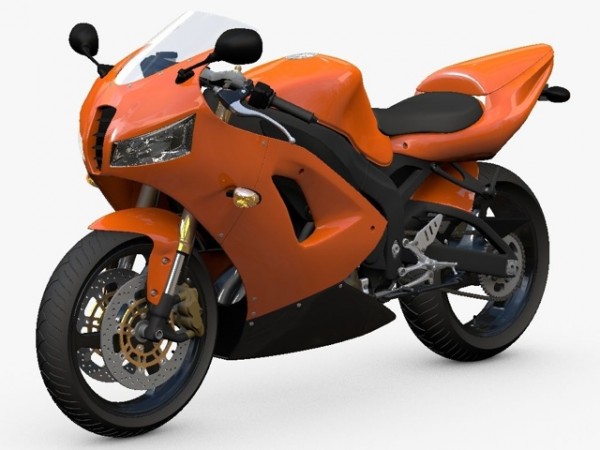I’ve been working on this project for a long time. It’s very close to being finished and I wanted to share a render from the end of the modeling phase. About 99% of the geometry is completed at this point and I’m about to begin the texturing phase. Unlike my previous models, this bike will not be fully UV Mapped. The model uses geometry to tell most of the story instead of heavy use of texture maps.

paul
April 9, 2012 — 5:04 pm
hi,
First of all. i just want to say, your bike models are amazing! and apparently you are one of very few 3d artists doing superbikes!
I’m a graphics designer working in the netherlands at an IT company as graphics designer, however i keep myself busy in my spare time learning maya. Not doing to bad on that front, but… still pretty much a novice.
Anyway, to get to the point. I want to do a custom paint job on my daytona 675, and i wanted to start a 3d model of a daytona so i can do a UV map and see what my paint job is going to look like. nothing commercial, but still. seems like a challenge. However, i just can’t seem to get things done right had a couple of throws at it, but my poly modeling is just not that good yet. So i was wondering is it ok to ask you for some tips?
if so: What software do you use? do you use image planes? or do you model by measuring and looking? or from photo’s? do you spend any time on engine detail? or is it mainly surface modeling?
I saw some turbosquid links to the model (little over my price range, but a fair price nonetheless!)
anyway. I would love to hear from you and get some tips.
thanks you,
sincerely
Paul
Jamie
April 9, 2012 — 5:37 pm
Hi Paul,
First off, thanks for the kind words and for taking the time to comment.
My weapon of choice is Cinema 4D. I’ve been using it for roughly ten years (on and off). I am also trained in the basics of Maya (I took a few semesters of it at Platt College in San Diego). I actually created two models in Maya; a pickup truck and the Aprilia sm750 Supermoto. Creating those in Maya taught me one thing: The software doesn’t really matter when it comes to poly/subdivision modeling. Just use what you’re comfortable in.
When modeling something like a bike, image planes are a must. I usually search the net for some decent orthogonal images and then any other photos I can find. It’s pretty useful to search the bike parts websites for a part if you’re unsure of what it looks like around back! You can also get basic dimensions and geometry from spec-sheets and review sites. That way you know the seat height, rake angle, wheelbase, etc.
Engine modeling is a tricky subject. If you’re going to see the engine like on a Supermoto[1] Supermoto[2], Buell, or KTM, then you’d better start with the engine. You can always go too far though; The top half of this engine has much more detail than you’d see in the final bike + engine composition.
On a bike like the Daytona, I just modeled the parts of the engine that show through the fairing. Everything else is pretty primitive.
Hope this was helpful!